Investing in silver offers a unique mix of benefits and potential risks, especially when considering physical silver versus the iShares Silver ETF (SLV). Holding physical silver provides ownership security that an ETF cannot match. With physical silver, investors are less exposed to the complexities and risks associated with paper-based assets. This tangible asset allows investors to navigate market fluctuations with more confidence.
Moreover, the management of ETFs like SLV often involves fees and potential limitations on availability, as seen when there were concerns about restricting new shares due to limited physical silver. On the other hand, physical silver can offer a straightforward and fee-free investment once purchased.
Enthusiasts argue that the direct control and security of having a physical asset make physical silver a safer bet. By understanding both sides of the coin, investors can make informed decisions that align with their financial strategy and goals.
Key Takeaways
- Physical silver offers ownership security not seen in ETFs.
- SLV and similar ETFs may have fees and restricted availability risks.
- Direct control over physical assets provides a sense of security.
Feel free to Download our “10 Must-Know Reasons to Buy Gold and Silver” PDF.
Understanding Silver as an Investment
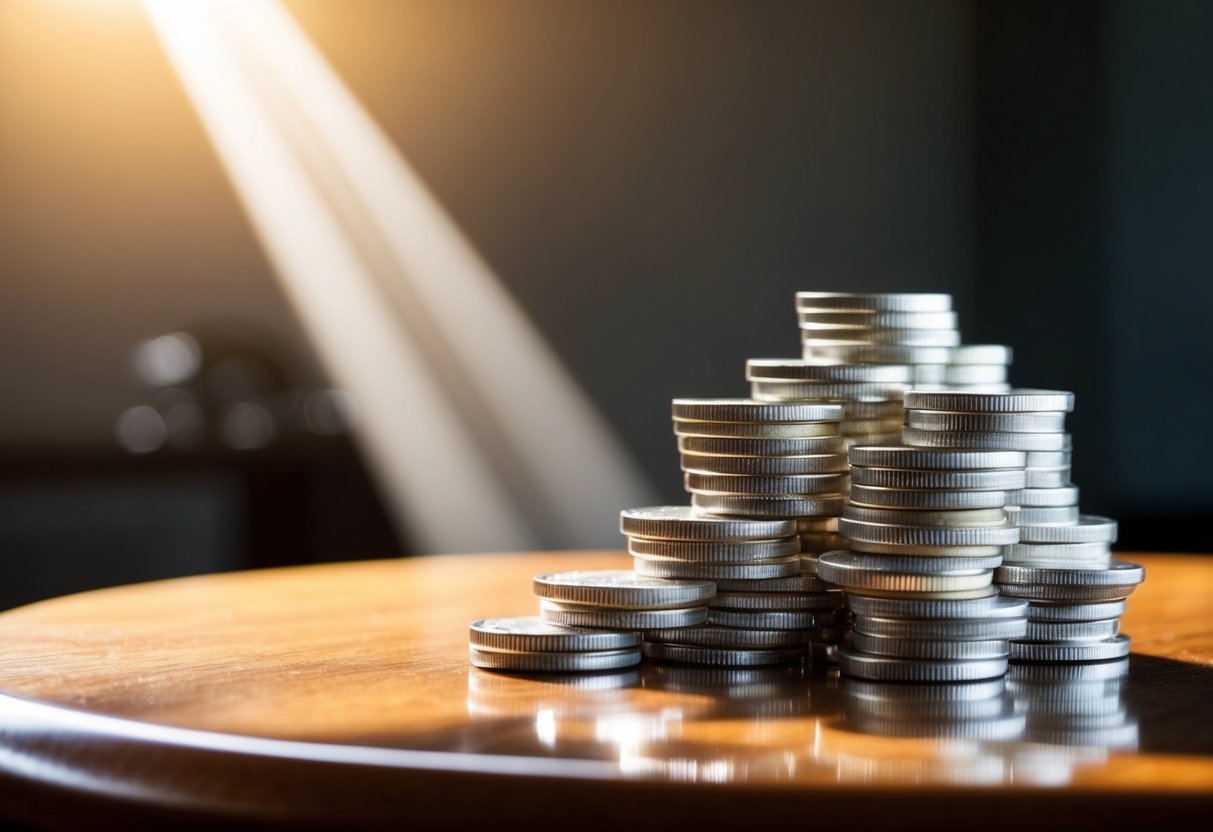
Silver plays a significant part in the investment landscape, particularly within precious metals. Its relationship to gold, differences between physical forms, and exchange-traded funds (ETFs) are key points that shape its role for investors.
Silver’s Role in the Precious Metals Market
Silver holds a unique position among precious metals. As both an industrial and monetary metal, it is versatile. This dual use impacts its demand and price dynamics. Unlike gold, which is primarily valued for its historical significance and ornamental use, silver has widespread industrial applications.
The demand for silver in electronics, solar panels, and batteries supports its importance in technological advancements. As industries evolve, silver’s relevance can grow, offering potential for investment growth based on industrial development.
Comparison to Gold
Gold often overshadows silver as a preferred investment in the precious metals market due to its status as a traditional store of value. Yet, silver offers some advantages.
Silver’s lower price per ounce makes it more accessible, encouraging diversification with less capital compared to gold. Historically, silver prices have shown more volatility. This can be a benefit for traders looking for dynamic market movements. Silver’s market is smaller, meaning it can offer greater returns when prices move in favor of investors.
Physical Silver vs. Silver ETFs
Investors can purchase physical silver, such as silver bullion, or through silver ETFs. Physical silver requires storage and might entail insurance costs, yet it holds intrinsic value. Physical ownership provides a tangible asset that does not depend on other entities.
In contrast, silver ETFs offer convenience. They track the price of silver and offer liquidity in the financial markets. ETFs like SIVR and SLV are more cost-effective than holding bullion. For some, the difference between physical silver and ETFs depends on personal preference for tangibility versus tradability.
The Advantages of Physical Silver Ownership
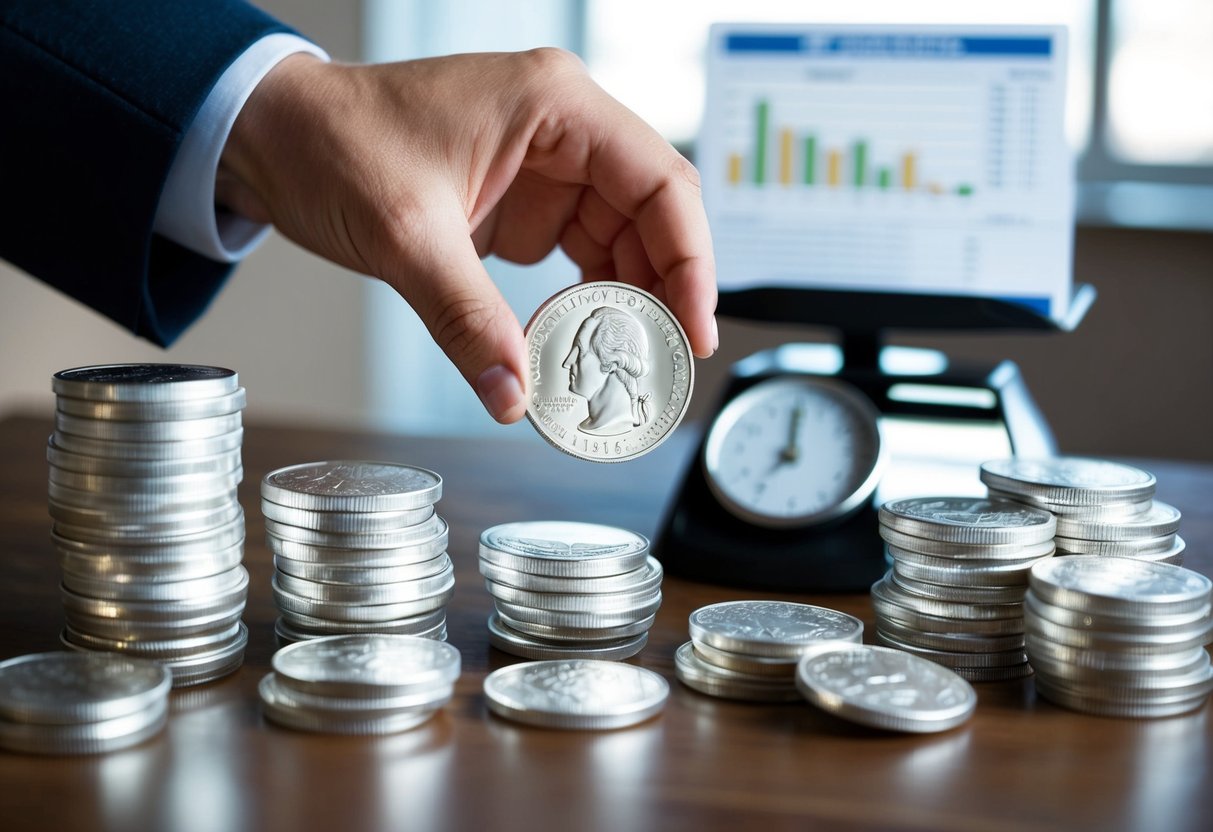
Owning physical silver presents unique benefits, such as direct control and lack of reliance on third parties. It remains a trusted store of value and offers a tangible form of investment.
Tangibility and True Ownership
Physical silver is a tangible asset that investors can hold in their hands. This tangibility provides a sense of true ownership that digital assets cannot match. Unlike ETFs, physical silver does not rely on electronic systems or third-party verification.
Silver’s physical form allows for direct possession, providing investors control without needing middlemen. This ownership ensures that the silver’s value is independent of market platforms, avoiding extra management fees associated with digital investments.
No Counterparty Risk
Physical silver eliminates counterparty risk, meaning owners do not rely on other parties to honor the investment. This is unlike paper silver, where the value depends on the issuer or market stability.
Silver owners avoid potential defaults and mishaps of digital markets, guarding against risks that affect stocks or bonds. This independence adds security, assuring investors their assets remain unaffected by institutional failures. Physical silver thus provides peace of mind during economic instability.
Store of Value Over Time
Silver’s reputation as a store of value spans centuries. It acts as a hedge against inflation, safeguarding purchasing power over time. Unlike currency, which can devalue, silver preserves its worth, reflecting its limited supply and industrial demand.
This historical reliability makes silver appealing for diversifying portfolios. As a hard asset, silver doesn’t erode in value with inflation, ensuring financial security. Its status as real money helps protect investments from economic fluctuations, offering stability in uncertain times.
Disadvantages of Silver ETFs
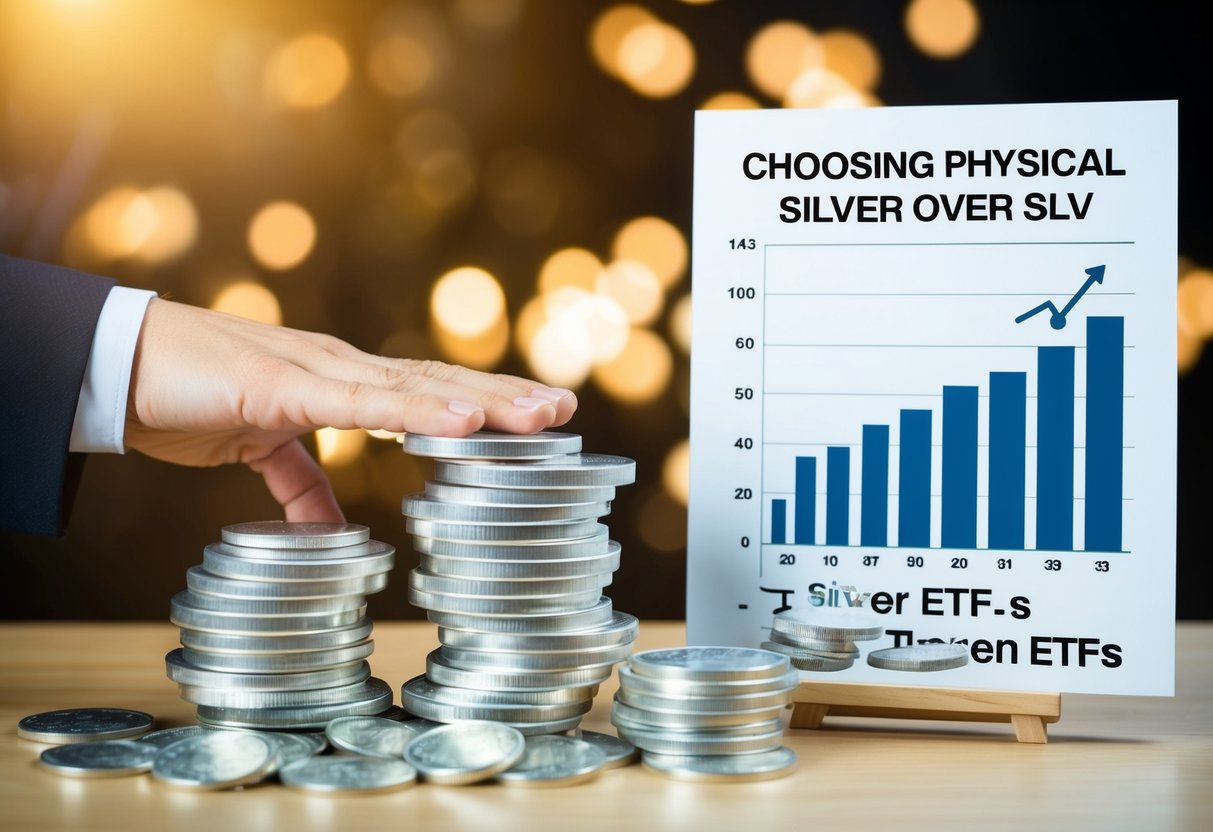
Silver ETFs, like the iShares Silver Trust (SLV), have certain drawbacks that investors should consider. These disadvantages can include concerns about potential price manipulation, counterparty risks, and the actual silver backing of these financial instruments.
Potential Price Manipulation
Silver ETFs might be subject to price manipulation. Since these ETFs track the price of silver but are also traded like stocks, they can be influenced by market activities unrelated to actual silver demand or supply. Large trades or speculations by big financial institutions can sway the ETF’s price, making it somewhat detached from the true market value of physical silver.
For investors looking for stability and alignment with the silver market itself, this potential disconnect can be worrying. While the ETFs offer liquidity and convenience, the price movements may not always reflect the actual performance of silver, presenting risks for those not closely monitoring the market dynamics.
Counterparty Risks and Liabilities
Counterparty risk is a significant concern in silver ETFs such as SLV. Because these financial products are managed by institutions, the performance and security of the investment depend on the trustworthiness and solvency of these companies. If the managing entity faces financial difficulties or fails to adequately execute its responsibilities, investors might not receive the expected returns.
Compared to holding physical silver, where one owns the asset directly, being reliant on third parties introduces layers of risk. While these institutions often have checks and balances, their potential failures or disputes pose added liabilities that investors must consider carefully.
Concerns Over Actual Silver Backing
There’s often skepticism about whether silver ETFs are fully backed by physical silver reserves. While funds like the iShares Silver Trust claim to have silver assets stored in vaults, verifying the precise amount and quality can be challenging.
Questions arise regarding the auditing processes and transparency of these holdings. This lack of clarity can lead investors to worry about the true backing of their investment, unlike physical silver trusts, which guarantee direct ownership of silver. Moreover, in distressed markets, the delivery mechanism and availability of the silver in these trusts can become problematic, making it a critical concern for informed investors.
Investment Mechanics of Buying Physical Silver
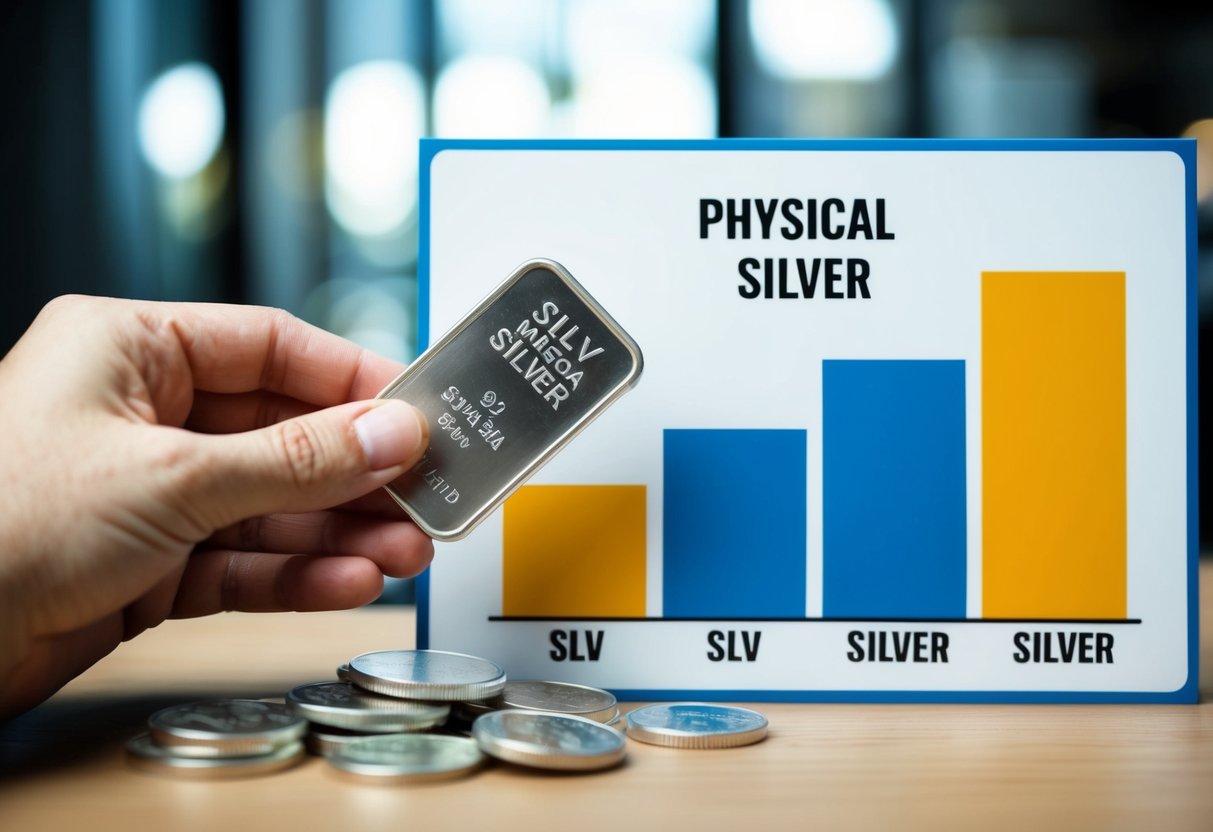
Purchasing physical silver involves understanding various investment types, recognizing the costs involved, and making informed decisions about storage. Each aspect plays a crucial role in ensuring a secure and effective investment.
Types of Physical Silver Investments
Investors can choose from several types of physical silver, including silver coins, silver bullion, and collectible items. Silver coins are popular due to their widely recognized value and legal tender status. Bullion bars, typically ranging from one ounce to larger weights, are a cost-effective choice for those focused on maximizing quantity.
Silver rounds, though similar to coins, lack legal tender but can be an affordable option. Collectibles or numismatic coins can carry higher premiums due to rarity and historical value. Each type offers different benefits and risks, depending on investment goals.
Understanding Premiums and Spot Price
The spot price of silver represents its current market price. However, purchasing physical silver often involves paying a premium. This premium covers production, distribution, and dealer profit. For coins, the premium might be higher due to minting costs and demand.
Investors should compare premiums among dealers to find the best deals. It’s crucial to understand that premiums fluctuate based on market conditions. For example, high demand can increase premiums. Knowledge of spot price trends can help investors make informed buying decisions.
Purchasing and Storage Considerations
When buying physical silver, choosing a reputable dealer is essential. Options include both local coin shops and online platforms. Evaluating reviews and comparing prices can help identify trustworthy sellers. Secure storage is a key consideration.
Home storage provides direct access but requires safety measures like safes or deposit boxes. Alternatively, third-party storage facilities offer security for a fee. Storage solutions should be chosen based on personal preference and level of convenience versus security. Insuring stored silver can give additional peace of mind, safeguarding the investment from unforeseen events.
Market Factors Influencing Silver Investments
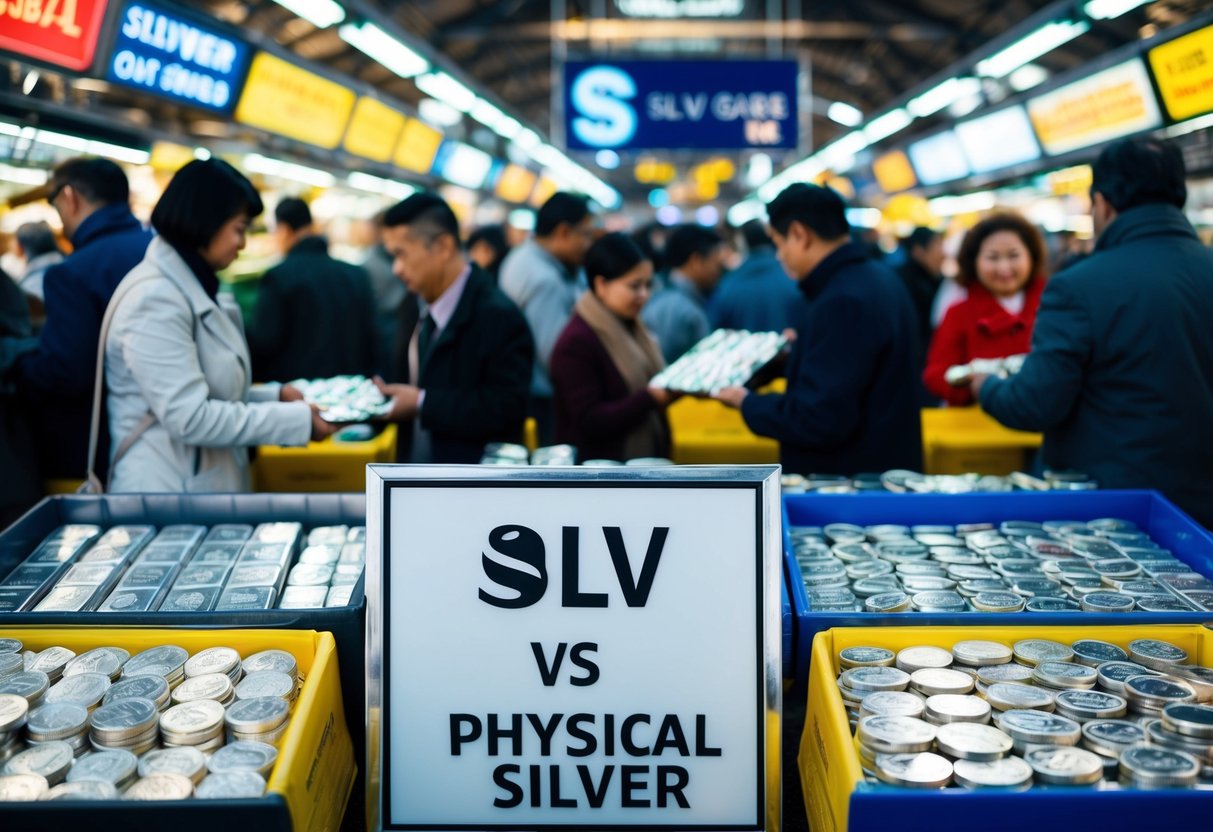
Silver investments are shaped by various factors that buyers must consider. Industrial and jewelry demand play crucial roles, as silver is used in many technologies and adornments. Economic indicators and market volatility also significantly influence silver prices, affecting investment timing and strategies.
Industrial and Jewelry Demand
Industrial demand for silver is a key driver in the silver market. Silver’s unique properties make it essential in electronics, solar panels, and medical instruments. This widespread use increases demand, especially as technology advances. The need for clean energy solutions could further boost demand for silver in solar power generation.
Jewelry also contributes to silver’s demand. Many prefer silver for its beauty and affordability compared to other precious metals. Emerging markets see rising silver jewelry purchases as incomes grow. This trend underpins a stable demand for silver, consistent with industrial needs.
Economic Indicators and Volatility
Silver prices are sensitive to economic shifts and market volatility. During economic uncertainty, investors often turn to silver as a hedge against inflation or currency devaluation. This safe-haven status can lead to increased investment in silver during volatile times, impacting its market demand.
Interest rates and inflation are important indicators influencing silver’s investment appeal. When inflation rises, silver typically becomes more attractive, preserving purchasing power. Global events and economic policies also play roles in shaping silver investments. Investors must watch these indicators to make informed decisions about their silver portfolios.
Strategic Considerations for Silver Investors
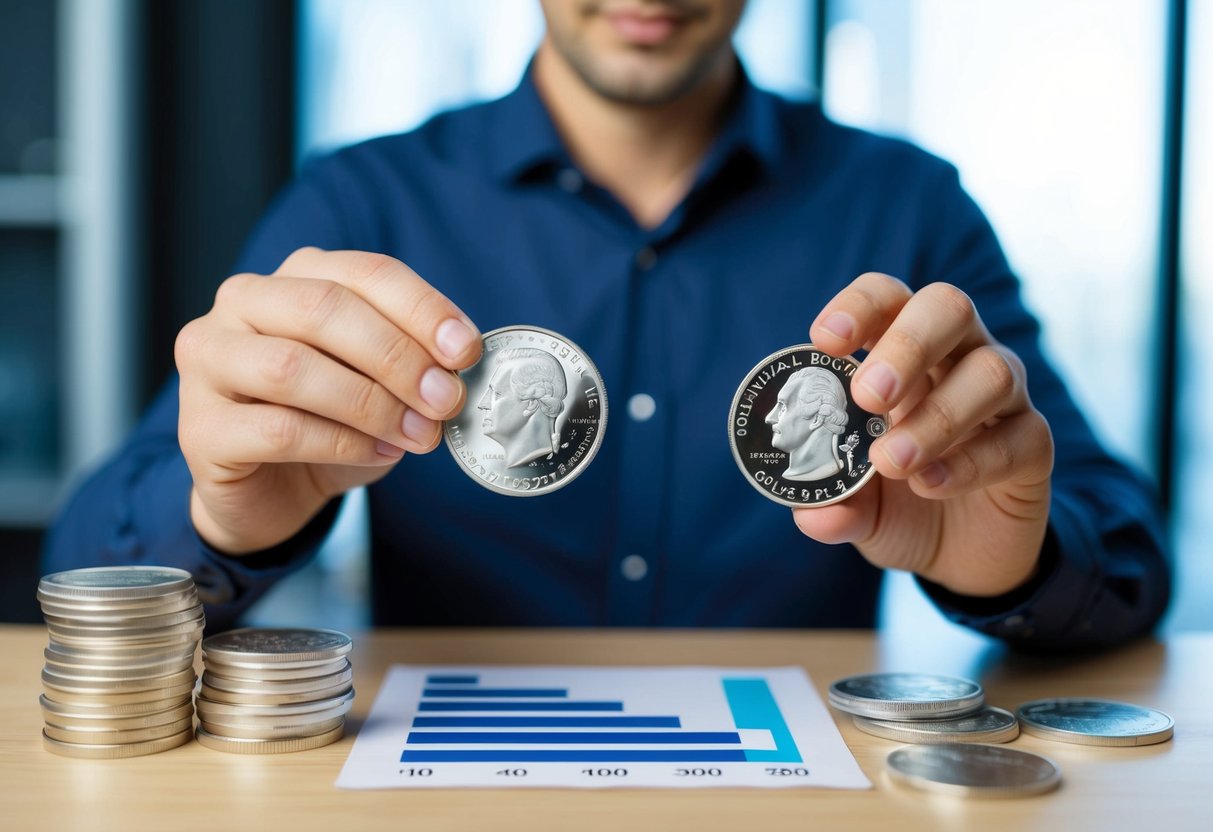
Silver can play a crucial role for investors considering precious metals. It provides opportunities for portfolio diversification, acts as protection against inflation, and offers unique advantages compared to other investments like stocks or bonds.
Diversified Portfolio and Risk Management
Including silver in an investment portfolio can help reduce risk. Silver often moves independently from other asset classes like stocks and bonds. This diversification can help protect against market volatility. Investing in physical silver means holding a tangible asset, which can be reassuring in times of economic uncertainty.
Balancing silver with other assets enhances risk management. As part of a diversified portfolio, silver can stabilize returns and provide a hedge against the unpredictable nature of some investments.
Silver as an Inflation Hedge
Silver is seen as an effective hedge against inflation. When fiat currencies lose value, silver often retains its purchasing power. This reliability makes silver appealing during periods of high inflation. Unlike paper assets, physical silver does not depend on the health of financial institutions.
Investors may choose silver to counteract inflation, as it is tangible and not easily influenced by government monetary policy. Historically, it has acted similarly to gold, safeguarding wealth during times of rising prices.
Comparing Silver to Other Investment Vehicles
Silver offers unique advantages over other investment vehicles. Physical silver provides a sense of security that digital or paper assets cannot. Unlike stocks or bonds, it doesn’t rely on corporate or governmental stability. Silver has high liquidity, allowing investors to quickly convert it to cash.
In comparison to the gold/silver ratio, silver is more affordable, making it accessible to a broader range of investors. It also typically has larger fluctuations, offering potentially greater returns. This flexibility and security make silver a strategic choice for those exploring diverse investment options.
Futures and Paper Silver Investments
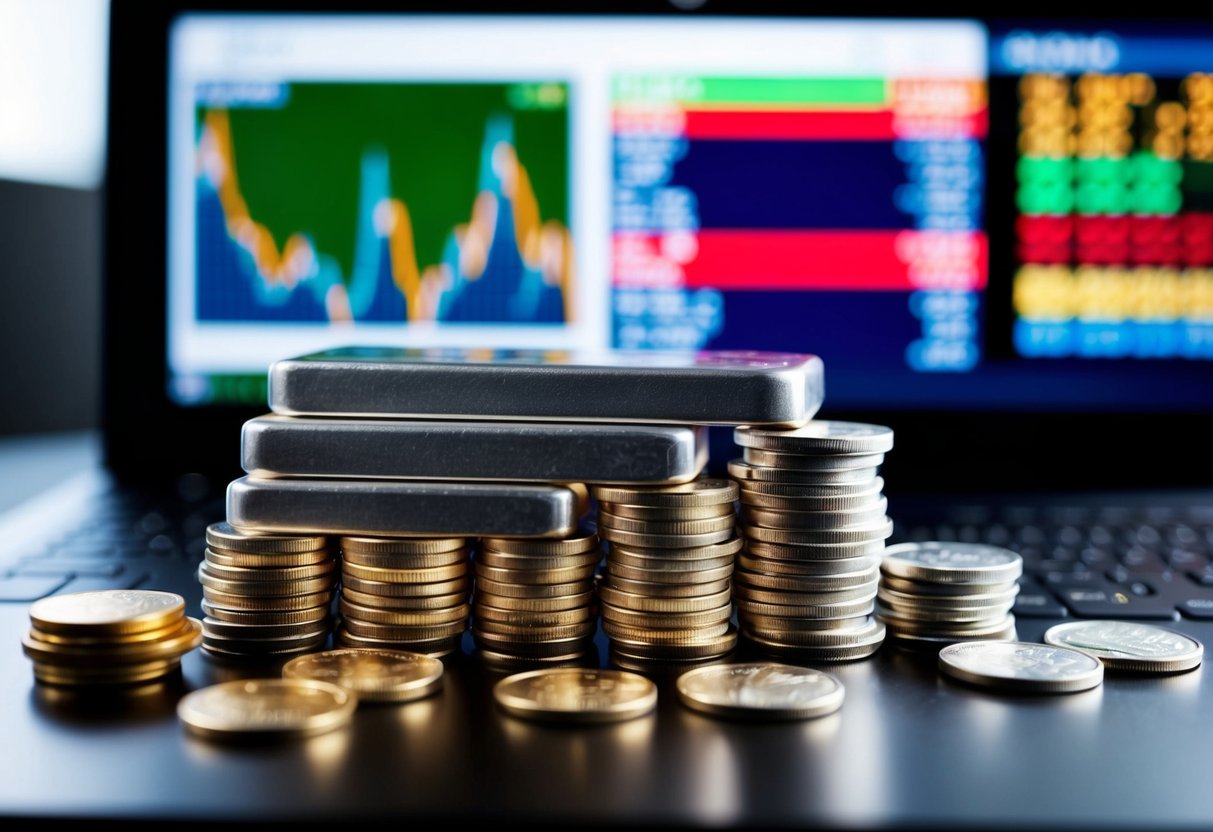
Investors have several options for trading silver, including through futures contracts and paper silver. These methods differ from owning physical silver in various aspects like cost, risk, and storage.
COMEX and the Futures Market
The COMEX is a major center for trading precious metals futures, including silver. It operates under the umbrella of the CME Group, providing a platform for buying and selling silver futures. These futures contracts are agreements to buy or sell a specific amount of silver at a predetermined date and price.
Participants in the futures market include individual investors, large financial institutions, and producers looking to hedge against price fluctuations. The COMEX sets standard contract sizes, most commonly a contract representing 5,000 ounces. Having a centralized market like the COMEX allows for efficient price discovery but can also expose participants to volatility.
Pros and Cons of Silver Futures Contracts
Silver futures contracts offer several advantages for investors. They allow for leverage, meaning traders can control a large quantity of silver with a smaller amount of money. This can amplify profits if prices move favorably. Additionally, futures markets are very liquid, resulting in easy entry and exit.
However, there are risks. Price fluctuations can lead to significant losses, particularly due to the leverage involved. Transaction costs, such as margin requirements and fees, can add up, affecting profitability. Many investors also cite that futures are more complex than buying physical silver, making them less suitable for beginners. Understanding these aspects is crucial for anyone considering involvement in silver futures.
Final Considerations for Potential Investors
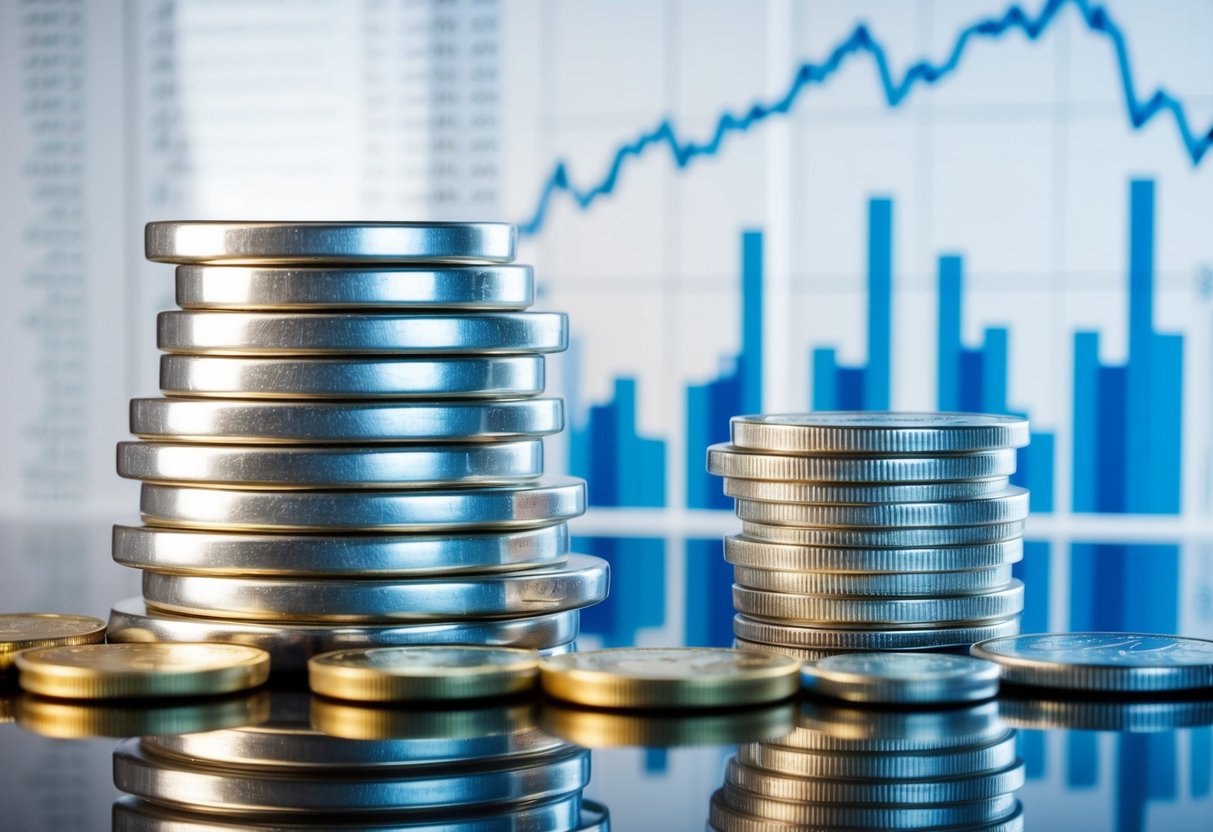
When thinking about investing in physical silver, one should weigh several aspects. Storage and security are key factors. Physical silver requires secure storage facilities, which can involve additional costs.
Comparing different investment forms is also important. While SLV provides a convenient way to invest in silver without the hassle of storage, there might be concerns about whether it is fully backed by physical silver.
Physical silver and PSLV can offer the reassurance of tangible assets. Physical gold shares similar benefits and draw investors looking for diversification. However, trading and liquidity should be considered, as selling physical metals can sometimes be more involved than selling shares.
Investors also need to consider tax implications. For example, PSLV offers potential tax advantages compared to SLV, as it might be taxed differently.
Understanding the costs involved in each option, such as premiums on physical silver, is crucial. These costs can affect the total return on investment. Furthermore, the market dynamics, including the influence of large institutions on prices, could play a significant role in the decision-making process.
By evaluating these factors, investors can make informed choices about whether to invest in physical silver, Stock ETFs like SLV, or alternatives like PSLV.
Frequently Asked Questions
Investing in silver involves choosing between physical silver and silver-backed ETFs like SLV. Each option has its unique benefits and risks that investors should consider.
Is it better to invest in physical silver or silver ETFs?
It depends on the investor’s goals and risk tolerance. Physical silver can offer security in owning a tangible asset. Silver ETFs provide a more convenient and liquid way to invest in silver without having to store the metal physically.
What are the differences between owning physical silver and a silver-backed ETF like SLV?
Owning physical silver involves storage and security concerns, while a silver ETF like SLV offers ease of trading and no need for storage. Physical silver is a tangible asset, whereas the ETF represents ownership of the silver indirectly through shares.
How does the performance of physical silver compare to that of silver ETFs?
Physical silver and silver ETFs both track the market price of silver. However, the performance of a fund like SLV might include additional factors such as management fees and market demand, which can slightly differ from the purely market-driven physical silver price.
What are the advantages of holding physical silver over paper silver or silver ETFs?
Physical silver provides a sense of ownership and control beyond digital investments. It can act as a hedge against economic instability and offers privacy, as transactions with physical silver can often be more discreet than those involving financial products.
Can investors expect the same returns from physical silver as they do from silver ETFs?
Returns can be similar as both are tied to the price of silver, but they are not identical. ETFs like SLV may charge fees that can impact net returns. Physical silver may incur costs related to storage and insurance that can affect investor gains.
What are the risks associated with purchasing physical silver compared to investing in a silver ETF?
Physical silver involves risks related to storage, security, and liquidity. It can be harder to sell quickly compared to an ETF. ETFs, while more convenient, carry risks such as market volatility and the trust that the fund is adequately backed by physical silver assets.


